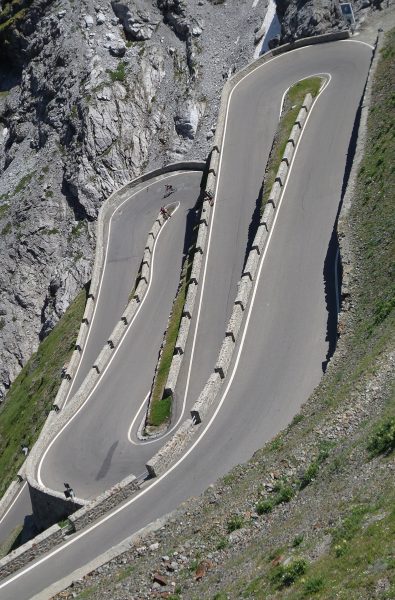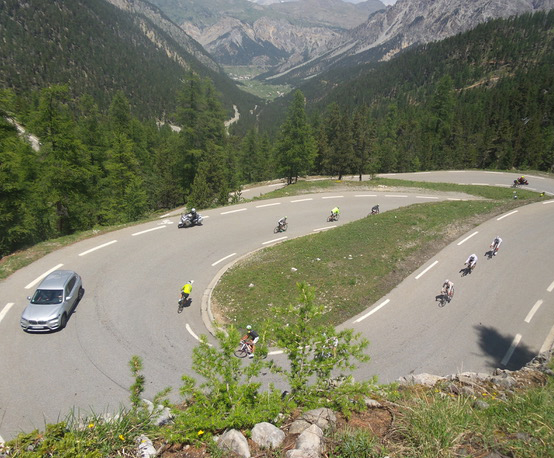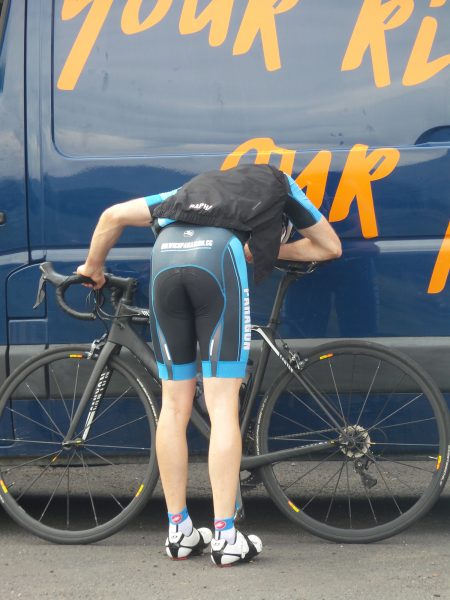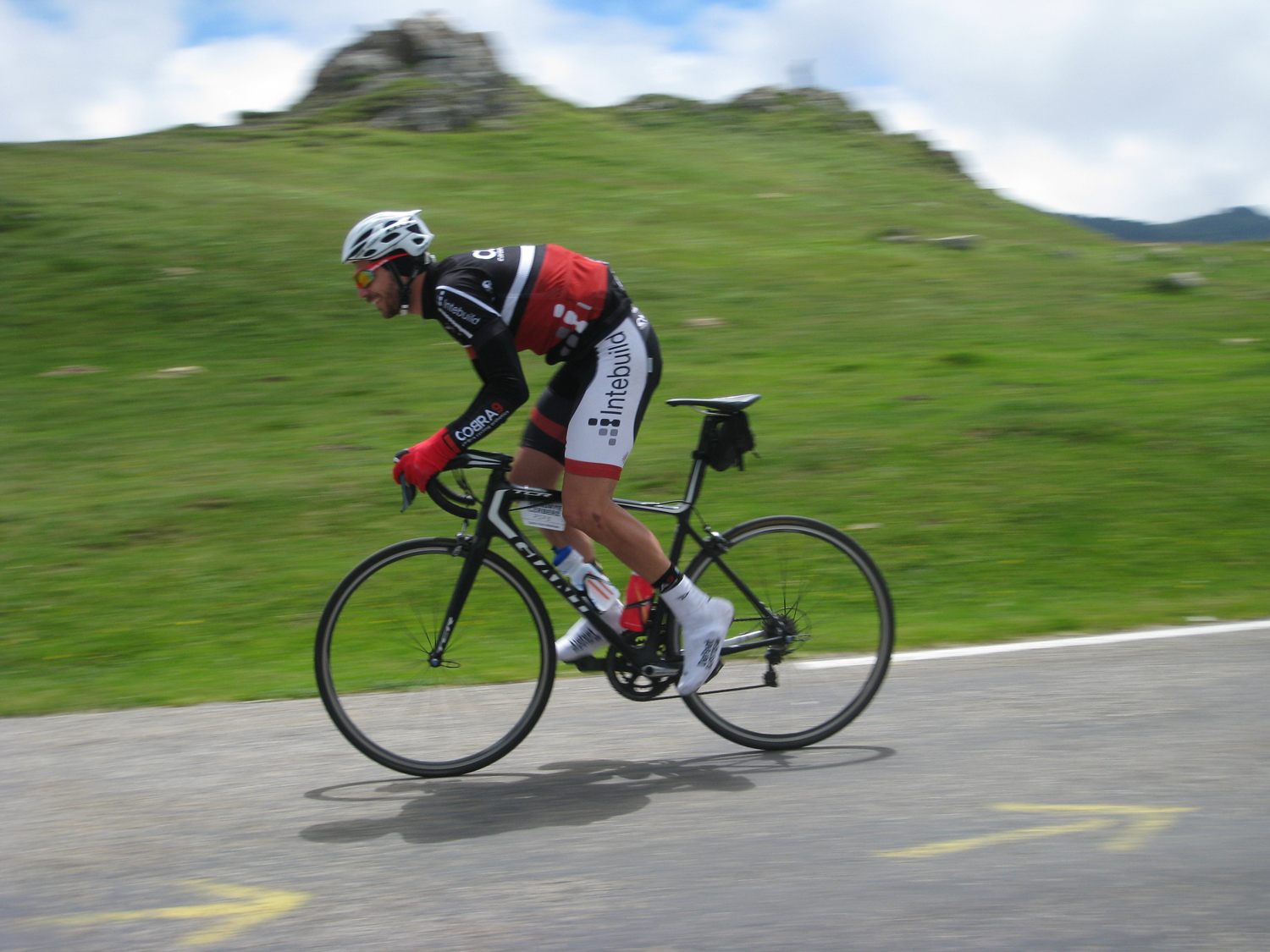The experience of ascending challenging, iconic climbs in beautiful, remote locations in the mountains of Europe is a great reason to choose a Marmot Tours cycling holiday! The joy and satisfaction felt from reaching the top of a col that has been dreamt about for months, possibly even years, will stay with you forever.
However, once the celebrations are over, you are typically faced with a descent, and the ride changes completely. How do you feel? Exhilarated, nervous, slightly apprehensive? Or do you see it as a trial to be tolerated and overcome? Marmot Tours guide, Graham Hey, neatly summarises a sometimes daunting topic with his observations, practical advice and recommended resources online to help hone your approach to descending so you can enjoy the buzz & stay safe.
Cycling Descents: the Mindset
You’ve reached the top of your dream col, taken a few photos, munched your way through the snacks, and put an extra windproof layer on for the descent. Your Marmot Tours guide has given you the run down about the next few kilometres so now is the point at which you need to focus: descending requires concentration! Leaving the security of the van can be a bit of a transition: feeling the wind on your face and your body cooling, a feeling of space around you as the road stretches into the distance. The drop in height ahead of you suddenly comes to the forefront.

Starting the descent you want to feel calm and relaxed. This reduces tension in your body which means it is easier to move around on the bike; a key to successful, flowing descending. It also means you won’t grip the bars, which can soon lead to fatigue and heavy, snatched braking.
Leaning on experience also helps. If you’ve done this kind of descent before, or have practised descending at home, you are already in a winning mindset. I often see a tentative descender at the beginning of a holiday become much more confident later in the trip, as a result of repetition of cornering moves.
There is, however, a safety limit that our brain imposes on us. No matter how good your technique, your rate of progress also depends on how brave you are! People use the phrase “oh, he’s a cautious descender” in a fairly disparaging way, even for cyclists who were actually descending pretty quickly! Nairo Quintana and Thibaut Pinot are two professional riders who used to have this label applied to them, and they are hardly slow!
Your brain imposes a bravery limit, which affects speed and technique. More often than not, the cyclist is thinking about the consequences of a problem, and descending efficiency goes out of the window. Sometimes it’s wise to just to turn the brain off a little – easy to say, hard to do… I know, as I am also a cautious descender and there is a lot of sense in that!
Descending Technique

You are now rolling towards your first corner – and the speed is picking up, quite quickly! You need to consider the technique of braking…
- Try to brake before you enter the corner, rather than when you are in it. This will mean you will go round the corner at an even speed and reduces the probability that you grab the brakes just at the wrong time and lose traction. It does mean that you will need to estimate a good speed at which to enter the corner – this will come from practice and will be based on the gradient and angle of the corner.
- Try to apply a little more force to the front brake, I personally like a balance of 70% front, 30% rear. This avoids the danger of the rear wheel locking up.
- Use as much of the road as is safe and practical: try to smooth the corners out by choosing a line that gives you visibility and space around the corner. Obviously, if it is summer and you are on a busy mountain pass in the Dolomites, drifting out towards the middle of the road isn’t safe. Likewise, on roads that have very acutely angled corners that you can’t see around, like Gran Canaria for example, this isn’t safe either. But if you are on a long, open, flowing alpine descent then use all the space on the road.
- The bike goes where you are looking – inevitably you ride in the direction your eyes are looking, so if you are staring through a bend at the beautiful view directly ahead, you will be on the bend before you know it and doing an emergency stop before the barrier! Look around the corner as you approach it, and try to avoid the temptation to focus on the road immediately ahead as this leads to erratic braking. It’s important to avoid that pothole, but you should have spotted it sooner!
- Be prepared to change your body position – ideally you should descend in the drops, as this gives you more control over the handlebars. Braking power is greater and it forces you to adopt a more aero position which means you feel a little less affected by the wind. If your bike geometry doesn’t allow you to comfortably ride in the drops it is time to do a couple of things – work on your lower back flexibility and change components on your bike. This may mean shortening the stem, raising the bars, or even changing the bike. Riding with your hands on the hoods is very hard work, you will crawl down a descent and the bike won’t be in full control.
- Approaching the corner, as you brake try to move your weight backwards. This will improve traction and counteract the braking force on your body. Rotate your feet so your outside leg is in the 6 o’clock position, press down, and at the same time push down on the drop of your handlebar nearest the inside of the corner. Lean into the bend with your inside knee pointing towards the corner. Your low centre of gravity, combined with the pushing-into-the-road feeling, will aid traction and inspire confidence!
- Follow experienced descenders – we get many experienced descenders on our trips and if you can follow their line, at a safe distance and speed, you will be able to relax so much more. Make sure though you give them enough space. And also be aware that some cyclists really don’t like being followed down a hill – either because they feel the pressure of having people behind them, or because they want to enjoy the solo experience of a rapid descent. If you are riding in a group, leave plenty of space so that you have time to react if someone spots a hazard.
Bike Set-up for Descending
Having a bike that is safely set-up for descending will also help your mindset. If you are worrying about whether you closed the rear brake, or whether you really tightened your stem bolts up correctly, you will have a troubling descent which will completely spoil the experience for you. And this should be one of the highlights of your holiday!
If you are at all worried about your bike set-up, stop immediately and check out the issue. A few seconds by the roadside will mean you can relax and enjoy the next few minutes.
It’s good practice to routinely check your bike for wear, and if you need some advice on how to do this ask your Marmot Tours guide. On a daily basis you need to keep an eye on your brake blocks, the condition of your rims and tyres, brake cables, quick releases, and stem, headset and saddle bolts. Check the bottle cages to make sure they are not rattling loose. These checks become even more important after a period of bad weather, when brake blocks wear at a much higher rate. Conversely, if you hit a period of hot weather, the melting tar combined with the horrible new chippings on freshly repaired roads can damage your tyres.
Another aspect of bike set-up which affects safe and enjoyable descending is the geometry of your bike. Our Marmot Tours rental bikes have semi-compact titanium frames with forks that have a short rake. This means you experience a more upright riding position, and the short rake makes for a very direct feeling through the steering. Experienced descenders who rent these bikes often comment that the bikes feel like they are going round the corners on rails. If you are bringing your own bike, be aware of how it feels going through a corner as this varies widely from bike to bike.
Environmental Conditions
The state of the road ahead of you will have a big impact on the speed at which you can descend, and your degree of confidence. There are a wide number of factors which affect the roads, and your Marmot Tours guide will help you understand what lies ahead of you. Things to bear in mind include:
Road condition
Newly repaired surfaces, typically found at the beginning of the summer season, lead to accumulations of loose chippings in the corners. Likewise, uneven surfaces may result if the road has been snow or frost damaged during the winter. This is very common on early season Pyrénéan trips for example.
Animals in the road!
Whether it is cows in the tunnels on the Col d’Aubisque, pigs on the roads in Corsica, or horses on the scary 23% ramps of the Angliru, animals provide a real hazard on descent. They are unpredictable in that you just can’t second guess what they are about to do! Not only that, but they leave deposits on the road which are there to catch the rider who isn’t concentrating on the slime ahead of them!

Weather
A sudden alpine storm can suddenly turn the road from a dry, dreamy experience into a running river of water, and getting off the bike and seeking shelter is sometimes necessary! I remember one of my first Marmot Tours trips during which we experienced a huge Pyrénéan storm coming off the Col de Menté. With electricity bouncing around us and the road turning into a river the sanctuary of the van was very welcome for the majority of the group.
Likewise, cold conditions can be very hazardous, even when it is dry. Making sure you are properly wrapped up, particularly around the extremities, is key if you are to ensure proper bike control. Shivering is an early indicator that you are becoming unsafe, you will start to experience a wheel wobble and you have to slow down. Its very hard to warm up again on a descent and really the only option you have is to either cycle up hill a little to rewarm or wait for your friendly Marmot Tours van to pass you and hitch a ride down!
We always aim to have a Marmot van at the top of every col so that you can put extra clothing on before the descent, and means we can talk to you about the road ahead.
Traffic
Many of our descents are on quiet roads, however during the summer the more popular cols in the Alps and Dolomites can get quite busy with holiday traffic. Generally a bike can descend faster than a vehicle (particularly a Marmot van!). Hopefully the driver will see you approaching in his mirrors and pull in. If not, you then have a difficult decision – whether to overtake or hang on the brakes. This obviously depends on your view of the road ahead and your assessment of oncoming traffic, the distance to the next bend and the speed you will need to get round the vehicle.
Fatigue when Descending
Imagine that you are on top of the Col de Jau, the final high point of the Raid Pyrénéan. Your guide has just given you the good news that it is now only 30km to the hotel in Prades. And the even better news is that it is virtually all downhill! The first few kilometres, however, are quite technical, with small, narrow roads, and little villages where you get a local crossing the street to go to the bar or the village dog waiting to pounce. And you’ve just ridden for 8 hours! So you are quite tired. This really is the time to dig deep, forget the racing descent, and concentrate on staying safe.

Some final thoughts…..
Descending doesn’t have to be that scary, apprehension-filled experience. It can be a massively rewarding, fun, part of your holiday that you will look back on for years to come! However, practice equals confidence and good technique and so it is well worth arriving on your holiday with some recent experience of descending.
What if it all gets too much? If you really do find a particular descent just too daunting, we’d much prefer you rode with us in the van. You don’t invalidate your Raid attempt by jumping in the van on descents, and risking a tumble really isn’t worth it. On rare occasions we even have to insist on you riding in the van if weather conditions mean the road is unsafe. Fortunately, these times are few and far between, so our overall message is to enjoy the ride and dream of that flowing, smooth descending line you are going to take on your next Marmot Tours road cycling holiday…..
Useful external links
• GCN’s top 10 tips for descending safely
• Bike Radar – How to Descend Safely
• Total Women’s Cycling – How to Overcome the Fear of Descending

